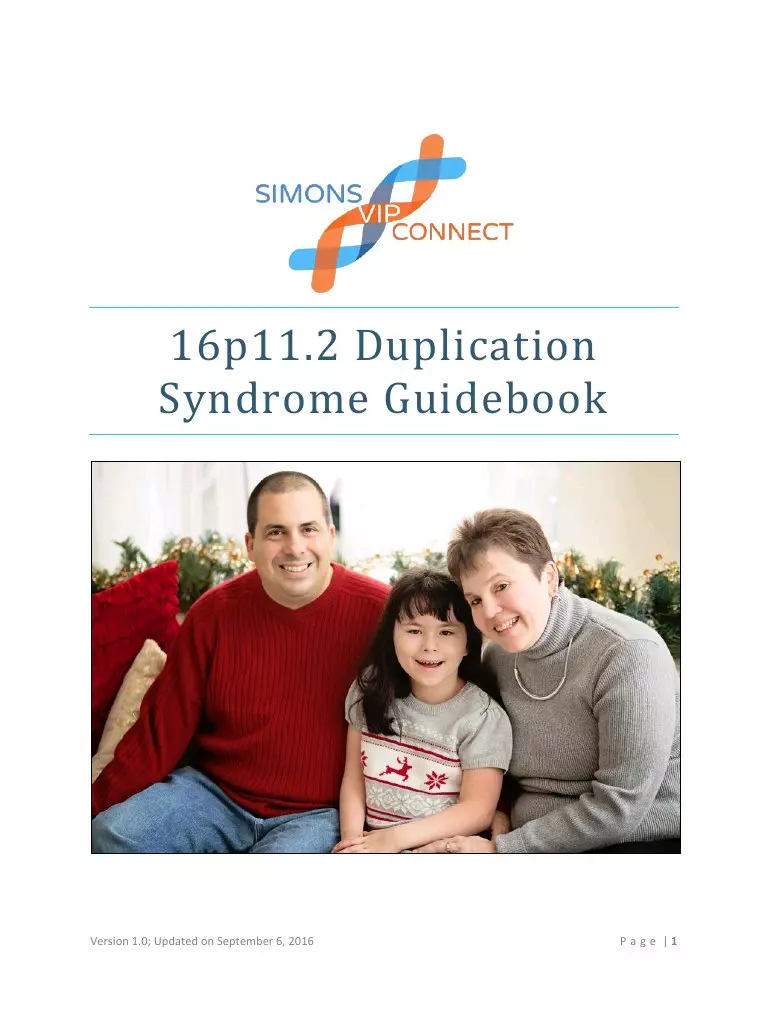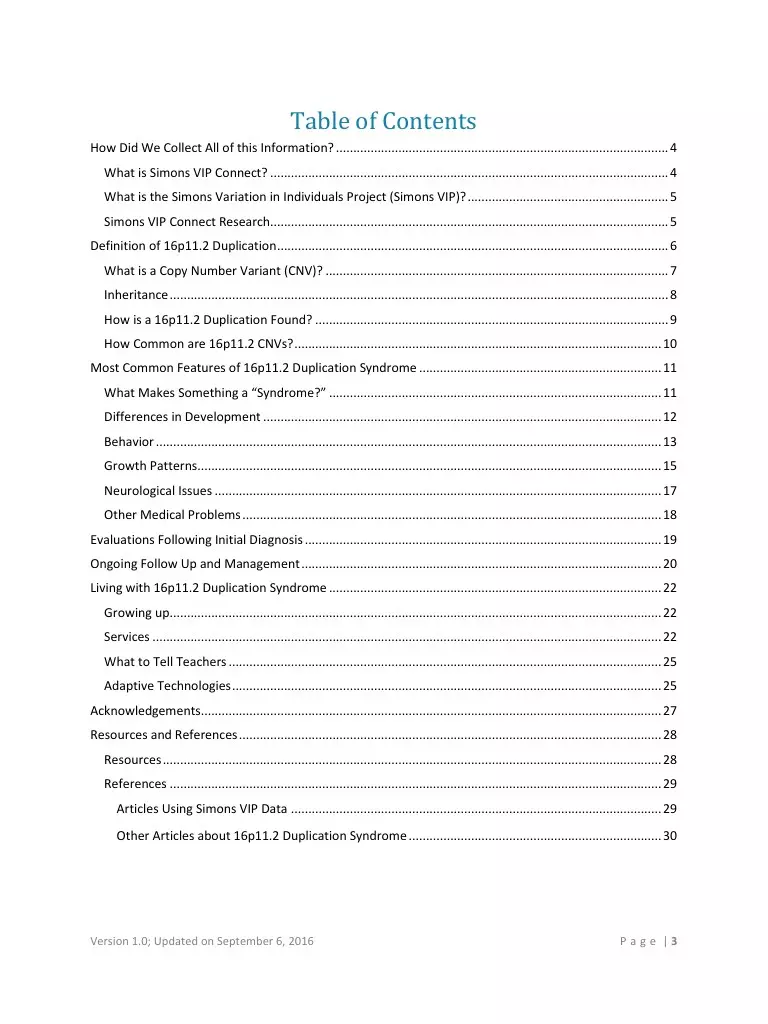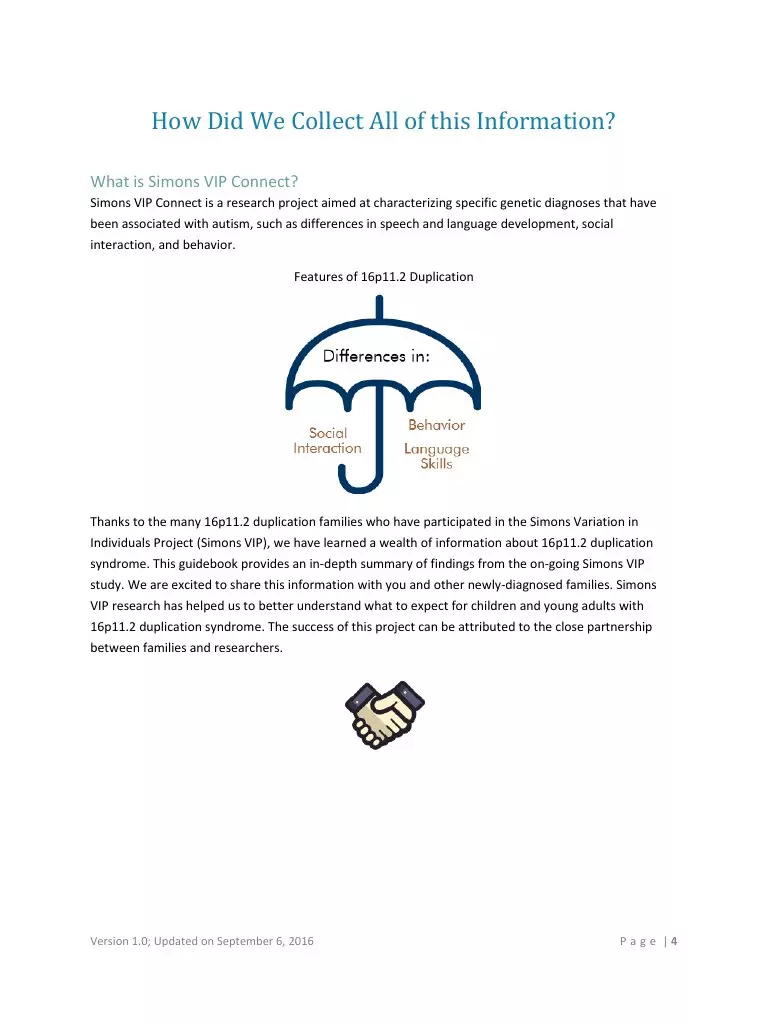16pDUP GUIDEBOOK FINAL VERSION (PDF)
File information
Author: Brokamp, Elizabeth K.
This PDF 1.5 document has been generated by Acrobat PDFMaker 11 for Word / Adobe PDF Library 11.0, and has been sent on pdf-archive.com on 21/09/2016 at 15:50, from IP address 159.240.x.x.
The current document download page has been viewed 2943 times.
File size: 1.21 MB (30 pages).
Privacy: public file





File preview
16p11.2 Duplication
Syndrome Guidebook
Version 1.0; Updated on September 6, 2016
P a g e |1
16p11.2 Duplication
Syndrome Guidebook
This guidebook was developed by the Simons VIP Connect Study Team to help you
learn important information about individuals with 16p11.2 duplication
syndrome. Inside, you will find that we review everything from basic genetics and
features of 16p11.2 duplication syndrome, to a description of clinical care and
management considerations.
- Simons VIP Connect
Version 1.0; Updated on September 6, 2016
P a g e |2
Table of Contents
How Did We Collect All of this Information? ................................................................................................ 4
What is Simons VIP Connect? ................................................................................................................... 4
What is the Simons Variation in Individuals Project (Simons VIP)? .......................................................... 5
Simons VIP Connect Research................................................................................................................... 5
Definition of 16p11.2 Duplication ................................................................................................................. 6
What is a Copy Number Variant (CNV)? ................................................................................................... 7
Inheritance ................................................................................................................................................ 8
How is a 16p11.2 Duplication Found? ...................................................................................................... 9
How Common are 16p11.2 CNVs? .......................................................................................................... 10
Most Common Features of 16p11.2 Duplication Syndrome ...................................................................... 11
What Makes Something a “Syndrome?” ................................................................................................ 11
Differences in Development ................................................................................................................... 12
Behavior .................................................................................................................................................. 13
Growth Patterns...................................................................................................................................... 15
Neurological Issues ................................................................................................................................. 17
Other Medical Problems ......................................................................................................................... 18
Evaluations Following Initial Diagnosis ....................................................................................................... 19
Ongoing Follow Up and Management ........................................................................................................ 20
Living with 16p11.2 Duplication Syndrome ................................................................................................ 22
Growing up.............................................................................................................................................. 22
Services ................................................................................................................................................... 22
What to Tell Teachers ............................................................................................................................. 25
Adaptive Technologies ............................................................................................................................ 25
Acknowledgements..................................................................................................................................... 27
Resources and References .......................................................................................................................... 28
Resources ................................................................................................................................................ 28
References .............................................................................................................................................. 29
Articles Using Simons VIP Data ........................................................................................................... 29
Other Articles about 16p11.2 Duplication Syndrome ......................................................................... 30
Version 1.0; Updated on September 6, 2016
P a g e |3
How Did We Collect All of this Information?
What is Simons VIP Connect?
Simons VIP Connect is a research project aimed at characterizing specific genetic diagnoses that have
been associated with autism, such as differences in speech and language development, social
interaction, and behavior.
Features of 16p11.2 Duplication
Thanks to the many 16p11.2 duplication families who have participated in the Simons Variation in
Individuals Project (Simons VIP), we have learned a wealth of information about 16p11.2 duplication
syndrome. This guidebook provides an in-depth summary of findings from the on-going Simons VIP
study. We are excited to share this information with you and other newly-diagnosed families. Simons
VIP research has helped us to better understand what to expect for children and young adults with
16p11.2 duplication syndrome. The success of this project can be attributed to the close partnership
between families and researchers.
Version 1.0; Updated on September 6, 2016
P a g e |4
What is the Simons Variation in Individuals Project (Simons VIP)?
In 2010, the Simons Foundation began working to build a collaborative relationship between families
and researchers to advance our understanding of 16p11.2 duplication syndrome. Families shared their
medical histories and participated in different assessments, and researchers compiled this information
and published what they’ve learned in medical journals. When families and researchers partner together
like this, we are able to address questions quickly and give back to the 16p11.2 community. Families
involved in Simons VIP Connect not only receive useful feedback by participating in research surveys, but
they also are helping other families now and in the future.
Simons VIP Connect has been an important resource for connecting and supporting families who once
felt alone after hearing about the diagnosis of 16p11.2. Now, the online community at Simons VIP
Connect extends from our website to other social networks, like Facebook, where families from all over
the globe support each other by sharing their stories and advice.
If you are not already a part of the online community, please visit our website at
https://www.simonsvipconnect.org. There you can learn more about 16p11.2 duplication syndrome by
participating in research, watching informational webinars, or asking an expert any questions that
haven’t been answered in this guidebook.
Simons VIP Connect Research
In the Simons VIP study, families partner with researchers to share information and learn about the
behavioral, psychological, physical, and medical features associated with different genetic changes. In
particular, Simons VIP is interested in genetic changes known to cause autism and other
neurodevelopmental disorders. Sharing information with Simons VIP Connect gives researchers access
to an incredible repository of data, including your child’s de-identified medical information, which
advances our knowledge about genetic causes of these disorders. Our model demonstrates the value of
sharing information to create a resource that is accessible by researchers across multiple medical
disciplines.
Version 1.0; Updated on September 6, 2016
P a g e |5
Definition of 16p11.2 Duplication
In every cell there is a copy of our DNA, which contains all of our genetic information. DNA is written in a
code made up of four letters – A, C, T, G – the “spelling,” or order, of these letters makes up the
instructions for everything our body does. Our DNA is very long so it needs to be coiled up into
packages, or structures we call “chromosomes.”
Slide 1: This project was made possible through the National Society of Genetic Counselors
and a grant from the Audrey Heimler Special Project Award
Humans have 46 chromosomes. We label the pairs of chromosomes 1 through 22, with the last pair
being the sex chromosomes. These are made up of either two X chromosomes (female) or one X and
one Y chromosome (male). Chromosomes are arranged into pairs because every person receives one
half of the pair from their mother and the other half of the pair from their father.
DNA is broken up into individual, readable segments called “genes.” We believe that humans have about
20,000 genes, and each gene provides a set of instructions for the body to perform a specific job.
When a person has a 16p11.2 duplication, typically we find that a group of about 29 genes (~600,000
letters of DNA code) are repeated, or duplicated (some people may have more or less than this
number). This means that one chromosome has the typical number of genes, while the other
chromosome has extra information. Researchers now know that this specific section of chromosome 16
contains genes that play an important role in health, development, and brain function.
Version 1.0; Updated on September 6, 2016
P a g e |6
What is a Copy Number Variant (CNV)?
The 16p11.2 duplication is also often referred to as a Copy Number Variant, or CNV. A CNV is a
difference in the number of copies of a particular section of genetic material. Since most people have
two copies of their genetic material (as described above – one copy from mom and one copy from dad),
a deletion (i.e., missing genetic information in a chromosome) or duplication (i.e., extra genetic
information in a chromosome) is considered a CNV.
Version 1.0; Updated on September 6, 2016
P a g e |7
Inheritance
This duplication can happen one of two ways. In most families, the duplication is inherited; meaning that
either mom or dad also has the 16p11.2 duplication and passed it on to their child. Simons VIP data
shows that three-quarters (75%) are likely to be inherited. However, it can also occur de novo, meaning
that the duplication is brand new in the family. Simons VIP data shows that one-quarter (25%) are
thought to occur de novo. This means that 1 out of 4 children with a 16p11.2 duplication did not inherit
it from mom or dad.
If a parent of a child with a 16p11.2 duplication is found to carry the duplication, then there is a 50%
that any of his or her other children will may have the same duplication.
Since this duplicated genetic material can be passed down from a parent to their children, it is possible
to test other family members to see if they have this same duplication. There are also tests that can be
done before, during, or after pregnancy to find out if the next child will have the same 16p11.2
duplication a parent carries. Talk to your genetic counselor about these testing options.
Version 1.0; Updated on September 6, 2016
P a g e |8
How is a 16p11.2 Duplication Found?
Children diagnosed with 16p11.2 duplication syndrome have had genetic testing, as this is a genetic
diagnosis. There are different types of genetic tests, and the ones we talk about here are able to detect
a typical 16p11.2 duplication.
Genetic testing has improved over the past 10-15 years, and we are now able to identify many different
types of genetic changes in people. We have genetic tests, including the microarray test, that look for
many different genetic changes all at once. Microarray testing is often the first test ordered when a
health care provider suspects that there may be a genetic reason for a child’s delays.
Another test, called Fluorescence In Situ Hybridization (FISH), may also be used to detect the 16p11.2
duplication. Since FISH testing is only targeted to one specific region/condition, some providers may
order this testing to determine if other relatives also carry the specific genetic change that was
identified in the family. However, the Simons VIP study team does not recommend that FISH testing be
used to detect 16p11.2 duplications. This is because some labs have trouble clearly and reliably
detecting the signal from extra genetic material, which may lead to an incorrect result. Instead, for
families with 16p11.2 duplications, we would suggest that a “targeted microarray” be used to test family
members.
Slide 2: This project was made possible through the National Society of Genetic Counselors
and a grant from the Audrey Heimler Special Project Award
Version 1.0; Updated on September 6, 2016
P a g e |9
Download 16pDUP GUIDEBOOK FINAL VERSION
16pDUP_GUIDEBOOK_FINAL_VERSION.pdf (PDF, 1.21 MB)
Download PDF
Share this file on social networks
Link to this page
Permanent link
Use the permanent link to the download page to share your document on Facebook, Twitter, LinkedIn, or directly with a contact by e-Mail, Messenger, Whatsapp, Line..
Short link
Use the short link to share your document on Twitter or by text message (SMS)
HTML Code
Copy the following HTML code to share your document on a Website or Blog
QR Code to this page

This file has been shared publicly by a user of PDF Archive.
Document ID: 0000485586.